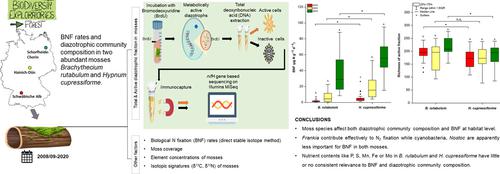当前位置:
X-MOL 学术
›
Environ. Microbiol.
›
论文详情
Our official English website, www.x-mol.net, welcomes your feedback! (Note: you will need to create a separate account there.)
Biological nitrogen fixation, diversity and community structure of diazotrophs in two mosses in 25 temperate forests
Environmental Microbiology ( IF 5.1 ) Pub Date : 2023-12-26 , DOI: 10.1111/1462-2920.16555 Christina Groß 1 , Shakhawat Hossen 2 , Sebastian Dittrich 3 , Klaus‐Holger Knorr 4 , Werner Borken 1 , Matthias Noll 2
Environmental Microbiology ( IF 5.1 ) Pub Date : 2023-12-26 , DOI: 10.1111/1462-2920.16555 Christina Groß 1 , Shakhawat Hossen 2 , Sebastian Dittrich 3 , Klaus‐Holger Knorr 4 , Werner Borken 1 , Matthias Noll 2
Affiliation

|
Many moss species are associated with nitrogen (N)-fixing bacteria (diazotrophs) that support the N supply of mosses. Our knowledge relates primarily to pristine ecosystems with low atmospheric N input, but knowledge of biological N fixation (BNF) and diazotrophic communities in mosses in temperate forests with high N deposition is limited. We measured BNF rates using the direct stable isotope method and studied the total and potentially active diazotrophic communities in two abundant mosses, Brachythecium rutabulum and Hypnum cupressiforme, both growing on lying deadwood trunks in 25 temperate forest sites. BNF rates in both mosses were similar to those observed in moss species of pristine ecosystems. H. cupressiforme fixed three times more N2 and exhibited lower diazotrophic richness than B. rutabulum. Frankia was the most prominent diazotroph followed by cyanobacteria Nostoc. Manganese, iron, and molybdenum contents in mosses were positively correlated with BNF and diazotrophic communities. Frankia maintained high BNF rates in H. cupressiforme and B. rutabulum even under high chronic N deposition in Central European forests. Moss N concentration and 15N abundance indicate a rather minor contribution of BNF to the N nutrition of these mosses.
中文翻译:

25个温带森林两种苔藓固氮生物的生物固氮、多样性和群落结构
许多苔藓物种都与固氮 (N) 细菌(固氮菌)有关,这些细菌支持苔藓的氮供应。我们的知识主要涉及大气氮输入量低的原始生态系统,但对氮沉积量高的温带森林中的生物固氮(BNF)和苔藓固氮群落的了解有限。我们使用直接稳定同位素方法测量了 BNF 率,并研究了两种丰富的苔藓(Brachythecium rutabulum和Hypnum cupressiforme)的总固氮营养群落和潜在活跃的固氮营养群落,这两种苔藓都生长在 25 个温带森林地点的枯木树干上。两种苔藓的 BNF 率与在原始生态系统的苔藓物种中观察到的相似。H. cupressiforme比B. rutabulum固定的 N 2多三倍,并且表现出较低的固氮丰富度。Frankia是最重要的固氮菌,其次是蓝藻发菜。苔藓中锰、铁、钼含量与BNF和固氮群落呈正相关。即使在中欧森林的长期氮沉降较高的情况下,Frankia在H. cupressiforme和B. rutabulum中仍保持较高的 BNF 率。苔藓 N 浓度和15 N 丰度表明 BNF 对这些苔藓 N 营养的贡献相当小。
更新日期:2023-12-26
中文翻译:

25个温带森林两种苔藓固氮生物的生物固氮、多样性和群落结构
许多苔藓物种都与固氮 (N) 细菌(固氮菌)有关,这些细菌支持苔藓的氮供应。我们的知识主要涉及大气氮输入量低的原始生态系统,但对氮沉积量高的温带森林中的生物固氮(BNF)和苔藓固氮群落的了解有限。我们使用直接稳定同位素方法测量了 BNF 率,并研究了两种丰富的苔藓(Brachythecium rutabulum和Hypnum cupressiforme)的总固氮营养群落和潜在活跃的固氮营养群落,这两种苔藓都生长在 25 个温带森林地点的枯木树干上。两种苔藓的 BNF 率与在原始生态系统的苔藓物种中观察到的相似。H. cupressiforme比B. rutabulum固定的 N 2多三倍,并且表现出较低的固氮丰富度。Frankia是最重要的固氮菌,其次是蓝藻发菜。苔藓中锰、铁、钼含量与BNF和固氮群落呈正相关。即使在中欧森林的长期氮沉降较高的情况下,Frankia在H. cupressiforme和B. rutabulum中仍保持较高的 BNF 率。苔藓 N 浓度和15 N 丰度表明 BNF 对这些苔藓 N 营养的贡献相当小。



























 京公网安备 11010802027423号
京公网安备 11010802027423号